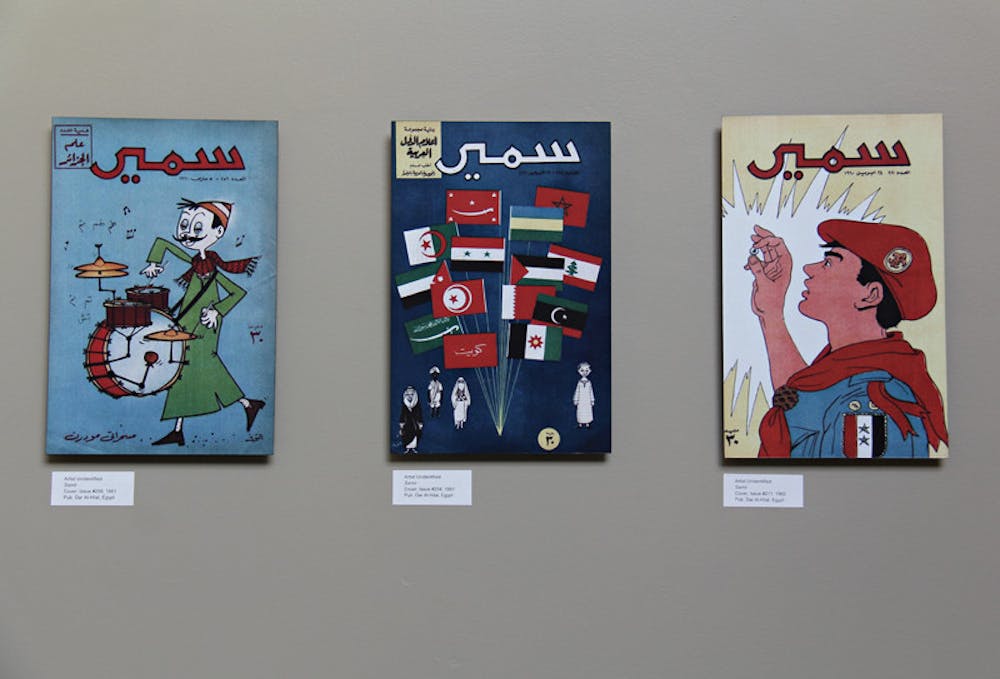Youthful characters mingle with starker images of violence in the comics that line the walls along the second floor of the Watson Institute for International Studies. Colorful images of Mickey Mouse adorned in lavish Arabic garments and headdresses create an aura that is distinctly familiar yet rich with Arabic culture.
The “Arab Comics: 90 Years of Popular Visual Culture” exhibition is on display Feb. 1 to March 15. The curation features Arabic comics crafted as early as the 1950s and as recently 2012.
Sarah Tobin, associate director of Middle East studies, said she hopes the exhibition will give spectators the opportunity to complicate the image of the Middle East that is typically conjured. Replacing many stereotypes of the region, the cartoons bring to life “some amazing images from the 20th century” in an accessible and familiar way, she added.
“Comics are perceived as a Western medium” but characters like Mickey Mouse, Tintin and Superman have in fact been present in the Middle East since the 1920s, said Nadim Damluji, who co-curated the exhibition with his sister, Mona Damluji.
Nadim Damluji said he first became interested in Arab comics after coming across a comic magazine at a book market in Cairo many years ago, adding that his interest has since developed into a passion. He is now a comic book scholar and critic, conducting extensive and in-depth research on the history of comics in Arab countries from the twentieth century to today.
He said his favorite comic in the exhibition, entitled “Mîkî” by an unidentified artist in 1964, features 14 images of Mickey Mouse framed by traditional Arabic architecture, each with a different skin tone. The piece overturns the monochromatic Mickey that graces most American televisions.
“They are taking something that’s so American and making it Arab,” Nadim Damluji said.
Damluji said he hopes the exhibit will disrupt the misconception that comics are strictly a Western product, not only through the children’s comics it features but also through the more contemporary works, which use comics as a medium to express the “tense things in the Middle East that are going on all the time.”
Comics allow artists to “tell personal stories about complicated situations,” he added.
The Arab comics provide an unconventional platform for audiences to learn about politics and current events, Tobin said, adding that comics can sometimes represent a satirical way to express opinions and subvert political norms.
More contemporary pieces from the Beirut-based comics collective Samandal include a black-and-white work that contrasts with the vibrancy across the hall. The piece entitled “Yogurt and Jam or How My Mother Became Lebanese” by Lena Merhej comprises nine panels that contradict its playful title. Tanks, gunfire and explosions, spread over nine years of violence, set a somber tone.
“Within the Arab world, there have been many cases of comics and illustration used in resisting oppression,” said Fouad Mezher, whose artwork is featured in the exhibit.
“The exhibit presents images that most people have never seen from the Middle East,” wrote Mona Damluji, co-curator of the exhibit, in an email to The Herald, adding that the organizers hoped to “pose new questions about the relationship between visual culture, Islam and the Arab world.”
Mona Damluji approached the Middle East studies program with the idea for the exhibit and symposium last semester. She wrote that when she approached Beshara Doumani, professor of modern Middle East history and director of Middle East studies, about the idea, he was “immediately enthusiastic as he agreed that very little has been written or shown in the U.S. to better understand this popular medium.”
The Middle East studies department will also host a symposium Feb. 26, which will showcase the comics while featuring artists and scholars from the United States and Lebanon.
Nadim Damluji said the symposium will add another dimension to the exhibition, which he hopes will act as a “conversation starter” to promote interest and to familiarize more people with the concept of Arab comics.
The exhibition also provides a unique opportunity to “highlight some important activists and artists who might struggle to have their work and contributions recognized so easily,” Tobin said.





